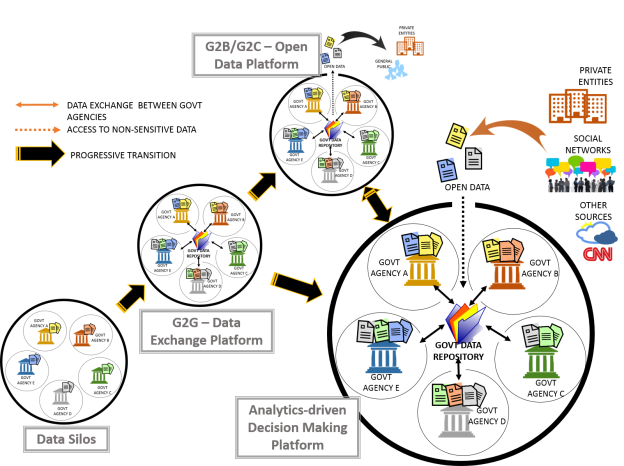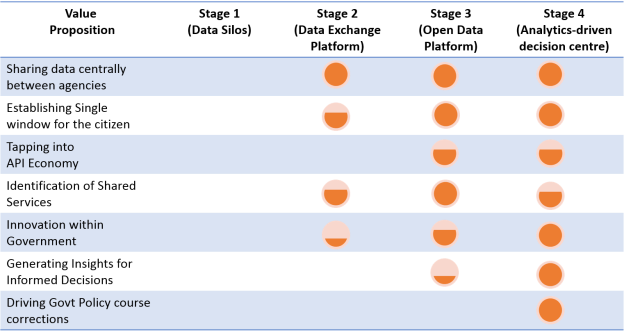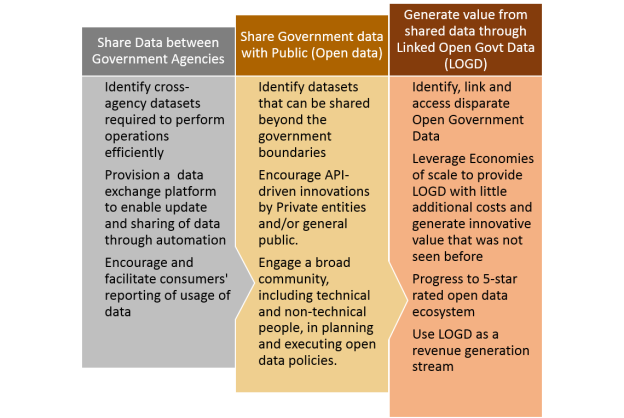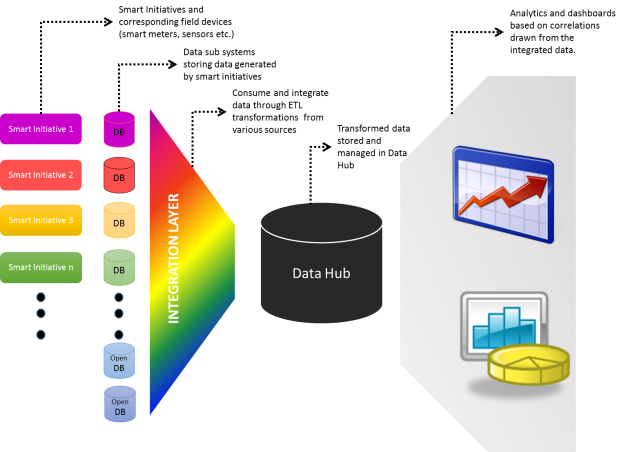While my previous blogs have focused on Smart City initiatives that have proven their relevance and effectiveness through implementations worldwide, I am testing unknown waters through this latest blog and attempting a leap into the future by bringing Blockchain to the Smart city context.
Blockchain technology has been around for some time and has gained popularity in its “bitcoin” avatar, but there has been recent interest across multiple industries to leverage it in their business context. Blockchain, in simple words, is based on a shared ledger technology allowing any participant in the business network to see the system of record. It has the potential of disrupting legacy operations and is evolving at a rather brisk pace. The financial services industry has been at the forefront of Blockchain adoption with its most important attributes – “security, transparency, indelibility and trust” – aligning naturally with their business operations. However, there are many other industries like logistics, travel and transport, legal services, government that are donning their thinking hats and ideating around this innovative technology.
This blog puts together a view of a potential set of use cases from the Smart Cities operational context that I believe are well suited for adopting Blockchain technology and deliver an enhanced experience to its residents. These are early days though, and these ideas do not necessarily have a precedent to assure a successful outcome. However, a Smart City is an ecosystem by itself and this blog provides a futuristic Point-of-View to identify how this ecosystem could benefit from Blockchain technology.
Before delving into further details, I believe a classification of the Smart Cities landscape is essential to map Blockchain initiatives accordingly. Not every initiative can be applied to every Smart City out there. Some of the initiatives are better driven by Government while there are a few that better suit Private ownership. So, the broad classification and a point of view of the initiatives that map to them are represented in the graphic below. The categorization of initiatives is not cast in stone but indicative of where I believe the initiative maps the closest.

The overlap between the X and Y axes in the 2*2 quadrant captures the relevant initiatives. For example, Public Owned Brownfield Smart Cities would gain immensely from leveraging Blockchain technology to deliver Social Services benefits while this is not the case with the Private Owned Smart Cities.
Let us get into these Blockchain applications in further detail:
- Smart Payments – As mentioned earlier, Blockchain technology has its roots in the Finance industry and has found early adopters in banks worldwide. In fact, Banks are now racing to harness the power of the Blockchain technology with a strong focus on e-payments and money transfers. Once the technology is proven, these can be implemented in a Smart city environment to execute utility bill payments, wallet-enabled transactions, payment of fines etc in a secure and transparent manner for its residents. This eases the life of the Smart City residents while assuring them that every fund transfer is being permanently recorded.
- Smart Land Records – Blockchain technology lends itself perfectly to help overcome property frauds by preventing or reducing it. The underlying reason for Blockchain to have gained in credibility is the indelible nature of its distributed ledger and transparency that comes with the ledger. Property prices have been on an upward swing worldwide and there are many fraudsters who are making most of the hype cycle by dubiously creating ownership records and disappearing as soon as they have made their money. These instances can be taken out of the system effectively and efficiently if every single transaction associated with a property is recorded in permanent ink, a.k.a Blockchain ledger. Smart cities, both private and government owned, can leverage the technology to establish a property management system that ensures peace of mind to all city stakeholders.
- Social Service benefits delivery – Most countries provide social service benefits to its citizens based on their socio-economic position in the society. The intent of these benefits is to result in upliftment of the society at large. However, there are umpteen instances when middlemen do not let these benefits reach the actual recipient by exploiting loopholes in the supply chain. The centralized nature of a Blockchain where everything can be tracked by the central authority will make it challenging, if not impossible, to fool the system thereby ensuring that all social benefits reach the intended recipients and all leakages are plugged. A smart city needs to accommodate every strata of society and join hands with the larger Government machinery to implement such a Blockchain-based initiative will be ideal in most of the developing world.
- Tax collection – The distributed ledger of Blockchain has the potential to help government in tax collections. As governments are making attempts to establish a simple tax system that places accountability on the individual/company to pay tax impromptu rather than charging them retrospectively, they could find their answer in Blockchain’s real-time, secure and reliable execution and recording of transactions. This results in plugging revenue leakages and provide data that is reliable both for taxpayers and tax authorities. For example, in India there is a push for tax reforms through the proposed GST policy that will establish comprehensive indirect tax on manufacture, sale and consumption of goods and services throughout India. Taxable goods and services are taxed at a single rate in a supply chain till the goods or services reach the consumer. This lends itself beautifully to track tax paid all along the supply chain using the reliable Blockchain technology.
- Smart Voting – Blockchain has found a rather unusual use in enabling transparent and reliable e-voting. While most countries have adopted various technologies over the years to improve voter percentages, e-voting adoption has yet to take off meaningfully worldwide. There are concerns that existing platforms are vulnerable to fraud, corruption and sabotage. It is to solve this challenge that Blockchain technology is being used to deliver convenience to the voters while ensuring security and reducing voting fraud. As mentioned earlier, Smart Cities are ecosystems by themselves and can use such Blockchain technology based voting systems to encourage participation in local elections (Example – Smart City Governance Boards) within the Smart city’s purview – delivering a signature city experience through effective and efficient resident engagement.
- Smart Transportation – Residents of almost every city in the world face transportation challenges today . The urban dweller looks for the convenience of moving from Point A to Point B with least hassle. It is this need that cab aggregators like Uber have tapped into and have a business model that is widely successful. However, what has also been irking some customers is the “centralized” nature of their operations with one HQ governing their operations worldwide. In response to this, Arcade City launched an innovative operating model being built on Blockchain technology in September 2016 that will decentralize the operations and provide lot more authority and decision making capability to the driver, who is the all-important “touchpoint” to the customer. The coming months will tell if this stands a chance of being disruptive. A Smart city can take this a step further and implement all transport services across various modes within the city – school buses could implement Blockchain-based identity, 3PL service providers could leverage it to make their supply chain more effective, public transport could be made more accurate and reliable etc. and innovations like the Arcade City initiative could provide alternates to move around that truly differentiate the city from the rest.
While these initiatives are futuristic in nature, the pace of innovations today is swifter than ever before. There are a number of Smart City initiatives being taken up worldwide and it is all about delivering a “differentiated signature city experience”. Towards this end, Blockchain technology and innovations around it could provide an alternate worth exploring. With all the hype also comes a word of caution – do not underestimate the technical and organizational challenges of building and adopting Blockchain-based systems. In summary, a pragmatic and thoroughly thought-through approach is suggested.








 While these 9 quality parameters are important, one needs to look into the specific business requirement and the corresponding datasets to assign weightage factors to each of these parameters suiting the context. It is also to be noted that each parameter will have further level of detail that has to be studied before declaring it be of high quality. For example, is Credibility defined only by the trustworthiness of sources – what if the data has undergone some transformation in the interim before being made available?
While these 9 quality parameters are important, one needs to look into the specific business requirement and the corresponding datasets to assign weightage factors to each of these parameters suiting the context. It is also to be noted that each parameter will have further level of detail that has to be studied before declaring it be of high quality. For example, is Credibility defined only by the trustworthiness of sources – what if the data has undergone some transformation in the interim before being made available? Most government agencies will have a mix of these different segments of rated data with a heavy leaning towards one-star and two-star data. While one-star and two-star data is fairly easy to generate, this limits data usage on the consumers’ side, when exposed and made available as Open Data. Generally, there are very few consumers willing to invest and/or competent enough to refine the provider data further to make it more consumable. And hence, the uptake of this kind of data will be low. Provider agencies will need to invest in progressing further on the maturity roadmap – make data non-proprietary, add semantics and link to related data/content. More importantly, they should adopt these new methods for all data generated till date and in the future. As a data provider agency progresses on this maturity roadmap, it will start seeing a corresponding adoption and value-generation from the larger city ecosystem. It is to be noted that the progression towards 5-star data will involve a change in organization practices and culture but once that becomes business-as-usual, the effort required is fairly low compared to the uptake one gets to see on the consumer-end.
Most government agencies will have a mix of these different segments of rated data with a heavy leaning towards one-star and two-star data. While one-star and two-star data is fairly easy to generate, this limits data usage on the consumers’ side, when exposed and made available as Open Data. Generally, there are very few consumers willing to invest and/or competent enough to refine the provider data further to make it more consumable. And hence, the uptake of this kind of data will be low. Provider agencies will need to invest in progressing further on the maturity roadmap – make data non-proprietary, add semantics and link to related data/content. More importantly, they should adopt these new methods for all data generated till date and in the future. As a data provider agency progresses on this maturity roadmap, it will start seeing a corresponding adoption and value-generation from the larger city ecosystem. It is to be noted that the progression towards 5-star data will involve a change in organization practices and culture but once that becomes business-as-usual, the effort required is fairly low compared to the uptake one gets to see on the consumer-end.
 The next level of progression will be to linked open government data (LOGD) and use this as a revenue stream. LOGD can demonstrate value in a wide range of use cases that were not thought of earlier. As an example, imagine the impact of accessing real-time public transport services data (from the Transportation department) to an event in the city (organized by Tourism department) that links up with the weather data (gathered from Meteorological department) and helps the citizen plan their journey.
The next level of progression will be to linked open government data (LOGD) and use this as a revenue stream. LOGD can demonstrate value in a wide range of use cases that were not thought of earlier. As an example, imagine the impact of accessing real-time public transport services data (from the Transportation department) to an event in the city (organized by Tourism department) that links up with the weather data (gathered from Meteorological department) and helps the citizen plan their journey.





